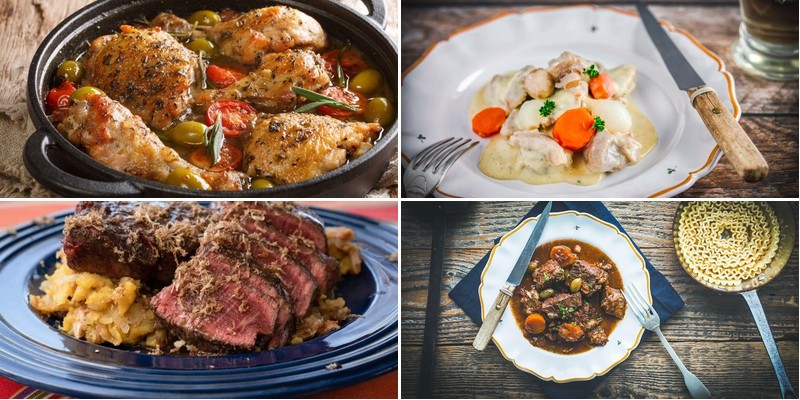Welcome, meat lovers! If you’ve ever dreamed of bringing the rich, savory flavors of French cuisine to your home kitchen, you’re in for a treat. From coq au vin’s deep, wine-infused comfort to steak frites’ crispy perfection, we’ve gathered 22 exquisite recipes that celebrate meat in all its glory. Get ready to impress your family and friends—let’s dive into these delicious French classics!
Coq au Vin with Rich Red Wine Sauce
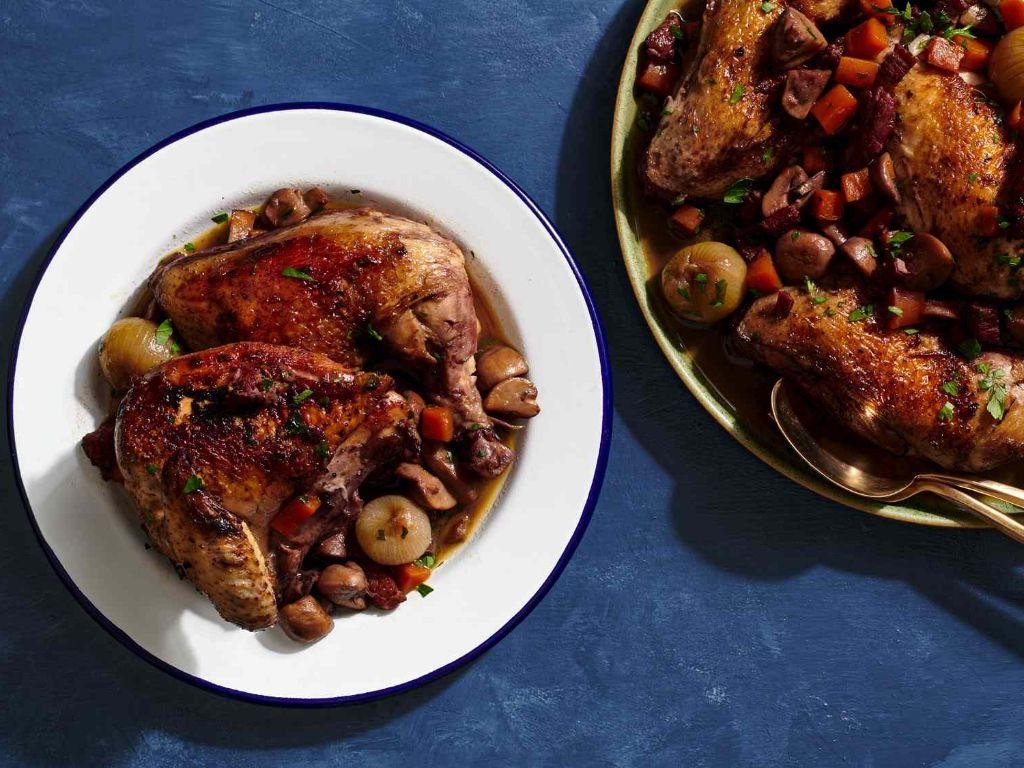
Zesty yet comforting, this classic French dish transforms humble chicken into an elegant masterpiece perfect for chilly evenings. Let me guide you through each careful step to ensure your coq au vin emerges perfectly tender with that signature rich wine sauce. Follow along precisely for foolproof results that will impress any dinner guest.
3
servings20
minutes95
minutesIngredients
– 4 chicken thighs (bone-in, skin-on for maximum flavor)
– 3 slices thick-cut bacon, chopped (I prefer applewood-smoked for subtle sweetness)
– 1 yellow onion, diced (about 1 cup)
– 2 carrots, sliced into ½-inch rounds
– 8 ounces cremini mushrooms, halved (baby bellas work wonderfully)
– 3 garlic cloves, minced
– 2 cups dry red wine (a Burgundy or Pinot Noir is my go-to)
– 1 cup chicken broth
– 2 tablespoons tomato paste
– 2 tablespoons all-purpose flour
– 3 tablespoons unsalted butter (divided)
– 2 tablespoons olive oil
– 1 bay leaf
– 1 teaspoon fresh thyme leaves
– Salt and freshly ground black pepper
Instructions
1. Pat chicken thighs completely dry with paper towels and season both sides generously with salt and pepper.
2. Heat 1 tablespoon olive oil in a large Dutch oven over medium-high heat until shimmering, about 2 minutes.
3. Place chicken thighs skin-side down and cook undisturbed for 6-8 minutes until golden brown and crispy.
4. Flip chicken and cook for 4 more minutes, then transfer to a plate.
5. Add chopped bacon to the same pot and cook for 5-7 minutes until crisp, stirring occasionally.
6. Remove bacon with a slotted spoon, leaving about 2 tablespoons of fat in the pot.
7. Add onions and carrots to the pot and cook for 6 minutes until softened, stirring frequently.
8. Stir in mushrooms and cook for 5 minutes until they release their liquid and begin to brown.
9. Add garlic and cook for 1 minute until fragrant.
10. Sprinkle flour over vegetables and cook for 2 minutes, stirring constantly to form a paste.
11. Whisk in red wine, scraping up all the browned bits from the bottom of the pot.
12. Stir in chicken broth, tomato paste, bay leaf, and thyme until well combined.
13. Return chicken thighs and any accumulated juices to the pot, submerging them in the liquid.
14. Bring to a simmer, then reduce heat to low, cover, and cook for 45 minutes.
15. Remove chicken from pot and stir in 2 tablespoons butter until melted and incorporated.
16. Cook sauce uncovered for 10 minutes until slightly thickened.
17. Return chicken to pot and stir in reserved bacon.
18. Cook for 5 more minutes until heated through.
19. Remove bay leaf and discard.
20. Stir in remaining 1 tablespoon butter for final gloss.
Creamy mashed potatoes make the perfect companion to soak up every drop of that luxurious wine sauce. The chicken should fall effortlessly from the bone while the mushrooms and carrots provide delightful textural contrast. Consider serving this in shallow bowls with crusty bread for dipping—it transforms a simple meal into a truly memorable dining experience.
Classic Beef Bourguignon Stew
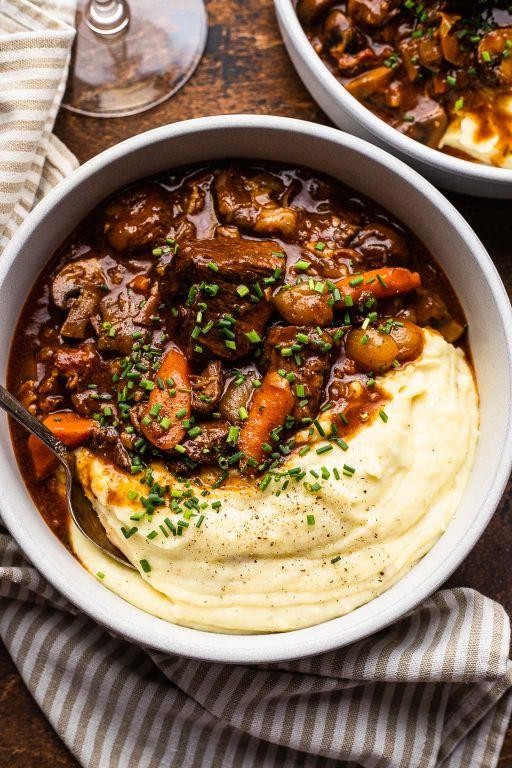
You’re about to make the most comforting French classic that’s perfect for cozy evenings. This beef bourguignon transforms humble ingredients into something truly extraordinary with slow, patient cooking.
6
servings30
minutes195
minutesIngredients
– 3 lbs beef chuck roast, cut into 2-inch cubes (I prefer well-marbled chuck for maximum tenderness)
– 6 slices thick-cut bacon, chopped (the smoky flavor makes all the difference)
– 1 large yellow onion, diced (sweet varieties work beautifully here)
– 2 carrots, peeled and sliced into 1-inch rounds (fresh, crisp carrots hold their shape best)
– 8 oz cremini mushrooms, quartered (their earthy flavor complements the beef perfectly)
– 3 cloves garlic, minced (freshly minced releases the most aroma)
– 2 cups dry red wine (I always use a Burgundy or Pinot Noir I’d actually drink)
– 2 cups beef broth (homemade if you have it, but good quality store-bought works fine)
– 2 tbsp tomato paste (this adds wonderful depth and richness)
– 2 tbsp all-purpose flour (for that velvety thickening power)
– 3 sprigs fresh thyme (dried just doesn’t compare to the floral notes of fresh)
– 2 bay leaves (these subtle herbal notes are essential)
– 2 tbsp olive oil (extra virgin is my go-to for better flavor)
– 1 tsp kosher salt (I find it seasons more evenly than table salt)
– ½ tsp black pepper, freshly ground (the aroma of freshly cracked pepper is unbeatable)
Instructions
1. Preheat your oven to 325°F to ensure even, gentle cooking throughout the stew.
2. Pat the beef cubes completely dry with paper towels—this step is crucial for proper browning.
3. Season all beef pieces evenly with kosher salt and freshly ground black pepper.
4. Heat 1 tablespoon olive oil in a large Dutch oven over medium-high heat until shimmering.
5. Working in batches, brown the beef cubes for 3-4 minutes per side until deeply caramelized.
6. Transfer browned beef to a plate, being careful not to overcrowd the pan during browning.
7. Add chopped bacon to the same pot and cook for 5-6 minutes until crisp and rendered.
8. Remove bacon with a slotted spoon, leaving the flavorful fat in the pot.
9. Add diced onion to the bacon fat and cook for 4 minutes until translucent.
10. Stir in sliced carrots and cook for another 3 minutes until slightly softened.
11. Add quartered mushrooms and cook for 5 minutes until they release their moisture.
12. Stir in minced garlic and cook for 1 minute until fragrant but not browned.
13. Sprinkle 2 tablespoons flour over the vegetables and cook for 2 minutes to remove raw taste.
14. Add tomato paste and cook for 1 minute while stirring constantly.
15. Pour in red wine, scraping up all the browned bits from the bottom of the pot.
16. Add beef broth and bring the mixture to a simmer for 2 minutes.
17. Return the browned beef and crisp bacon to the pot along with any accumulated juices.
18. Tuck fresh thyme sprigs and bay leaves into the liquid.
19. Cover the Dutch oven with a tight-fitting lid and transfer to the preheated oven.
20. Braise for 2 hours and 30 minutes until the beef is fork-tender.
21. Remove from oven and let rest for 15 minutes before serving.
Beef bourguignon achieves that magical transformation where tough cuts become meltingly tender while the wine reduces into a rich, glossy sauce. The mushrooms and carrots maintain just enough texture to contrast the succulent beef. Beyond classic mashed potatoes, try serving it over creamy polenta or with crusty bread to soak up every last drop of that incredible sauce.
Duck Confit with Garlic and Thyme

Preparing duck confit might seem intimidating, but breaking it down methodically makes this French classic surprisingly approachable. Picture tender, fall-off-the-bone duck legs with crispy skin, infused with aromatic garlic and earthy thyme—it’s a dish that rewards patience with incredible flavor.
2
servings30
minutes180
minutesIngredients
- 4 duck legs (I prefer sourcing from a trusted butcher for better fat coverage)
- 2 cups duck fat (rendering your own adds depth, but store-bought works perfectly)
- 8 garlic cloves (fresh, plump cloves release the best aroma)
- 6 sprigs fresh thyme (dried lacks the vibrant punch, so fresh is essential)
- 1 tbsp coarse kosher salt (it adheres better to the duck skin than fine salt)
- 1 tsp black peppercorns (lightly crushed to release their oils)
Instructions
- Pat the duck legs completely dry with paper towels to ensure crispy skin.
- Rub the duck legs evenly with coarse kosher salt on all surfaces.
- Place the salted duck legs in a shallow dish and refrigerate uncovered for 12 hours to draw out moisture.
- Preheat your oven to 300°F for gentle, slow cooking.
- Rinse the duck legs under cold water to remove excess salt and pat dry again.
- Arrange the duck legs snugly in a single layer in an oven-safe baking dish.
- Scatter the garlic cloves, fresh thyme sprigs, and crushed black peppercorns around the duck legs.
- Completely submerge the duck legs in melted duck fat, ensuring no parts are exposed.
- Cover the baking dish tightly with aluminum foil to trap steam and prevent browning.
- Bake at 300°F for 2.5 hours until the meat pulls easily from the bone.
- Remove the baking dish from the oven and let the duck cool in the fat for 30 minutes.
- Transfer the duck legs to a clean plate, straining and reserving the garlic-infused fat for future use.
- Heat a skillet over medium-high heat and place the duck legs skin-side down.
- Sear for 3–4 minutes until the skin is golden brown and crispy.
- Flip and sear the other side for 2 minutes to warm through.
The result is duck with a crackling-crisp exterior that gives way to impossibly tender, garlic-scented meat. Try serving it over creamy polenta to soak up the rich juices, or shred it into a hearty salad with bitter greens for contrast. This dish truly showcases how simple ingredients, when treated with care, create something extraordinary.
Traditional Cassoulet with Sausages
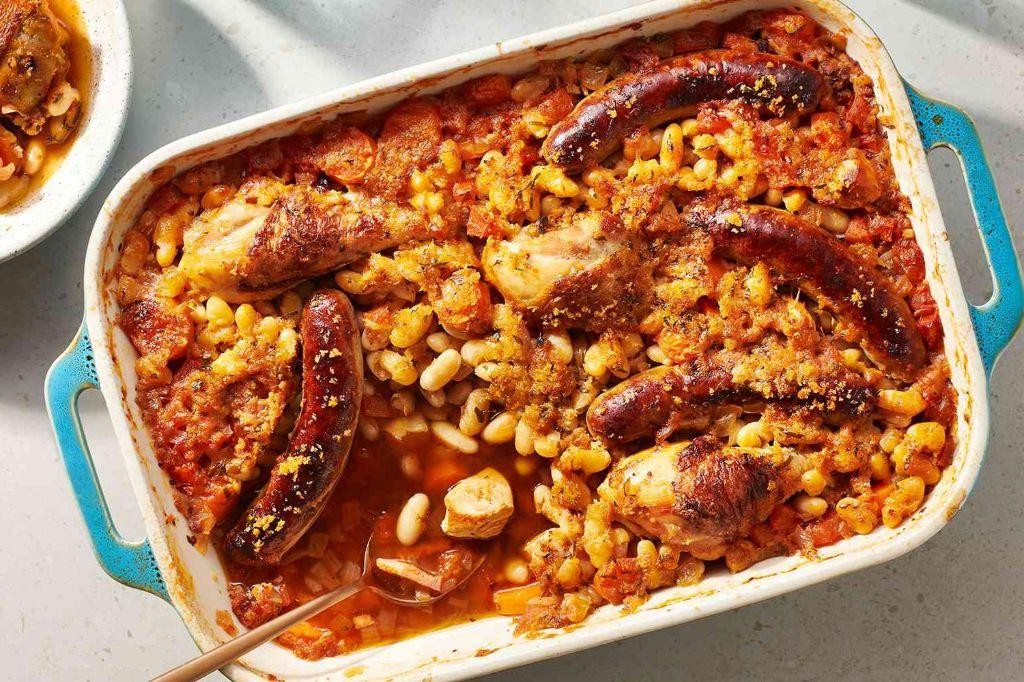
Tackling a traditional cassoulet might seem daunting, but breaking it down into clear, manageable steps makes this rustic French dish surprisingly approachable for any home cook. This comforting bean and sausage casserole builds layers of flavor through simple techniques that yield incredible results.
6
servings30
minutesIngredients
– 1 pound dried Great Northern beans (I find these hold their shape better than canned)
– 4 cups chicken stock (homemade if you have it, but good quality store-bought works fine)
– 1 large yellow onion, diced (about 2 cups)
– 4 garlic cloves, minced (fresh is essential here)
– 2 tablespoons tomato paste (I prefer the double-concentrated type for deeper flavor)
– 1 pound smoked sausage, sliced into 1-inch pieces (andouille adds nice spice)
– 2 tablespoons olive oil (extra virgin is my go-to for sautéing)
– 1 teaspoon dried thyme (rubbed between your fingers to release oils)
– 1 bay leaf (remove this before serving – it’s not edible)
– 1/2 teaspoon black pepper (freshly ground if possible)
Instructions
1. Rinse the dried Great Northern beans under cold running water in a colander, picking out any debris or shriveled beans.
2. Place the rinsed beans in a large Dutch oven and cover with 2 inches of cold water, then let them soak for 8 hours or overnight.
3. Drain the soaked beans completely and return them to the clean Dutch oven.
4. Add the chicken stock to the beans, ensuring the liquid covers the beans by about 1 inch.
5. Heat the Dutch oven over medium-high heat until the stock begins to simmer, about 5-7 minutes.
6. Reduce the heat to low, cover the pot, and simmer the beans for 45 minutes until they’re tender but still hold their shape.
7. While the beans simmer, heat olive oil in a large skillet over medium heat until it shimmers, about 2 minutes.
8. Add the diced onion to the hot oil and cook, stirring frequently, until translucent and soft, about 8 minutes.
9. Stir in the minced garlic and cook for 1 minute until fragrant but not browned.
10. Add the tomato paste to the onion mixture and cook for 2 minutes, stirring constantly to prevent burning.
11. Add the sliced sausage to the skillet and cook until lightly browned on both sides, about 5 minutes total.
12. Transfer the sausage mixture to the pot with the partially cooked beans.
13. Stir in the dried thyme, bay leaf, and black pepper until well combined.
14. Preheat your oven to 300°F and position a rack in the center.
15. Cover the Dutch oven and bake the cassoulet for 2 hours, checking occasionally to ensure it maintains a gentle simmer.
16. Remove the lid and continue baking for 30 minutes until the top develops a golden crust and the liquid has thickened.
17. Carefully remove the bay leaf before serving.
Final bites reveal creamy beans that have absorbed all the savory sausage flavors, creating a dish where each component melds into comforting harmony. Serve this cassoulet in deep bowls with crusty bread for dipping into the rich cooking liquid, or top with buttery breadcrumbs for extra texture contrast.
Tender Filet Mignon with Périgourdine Sauce
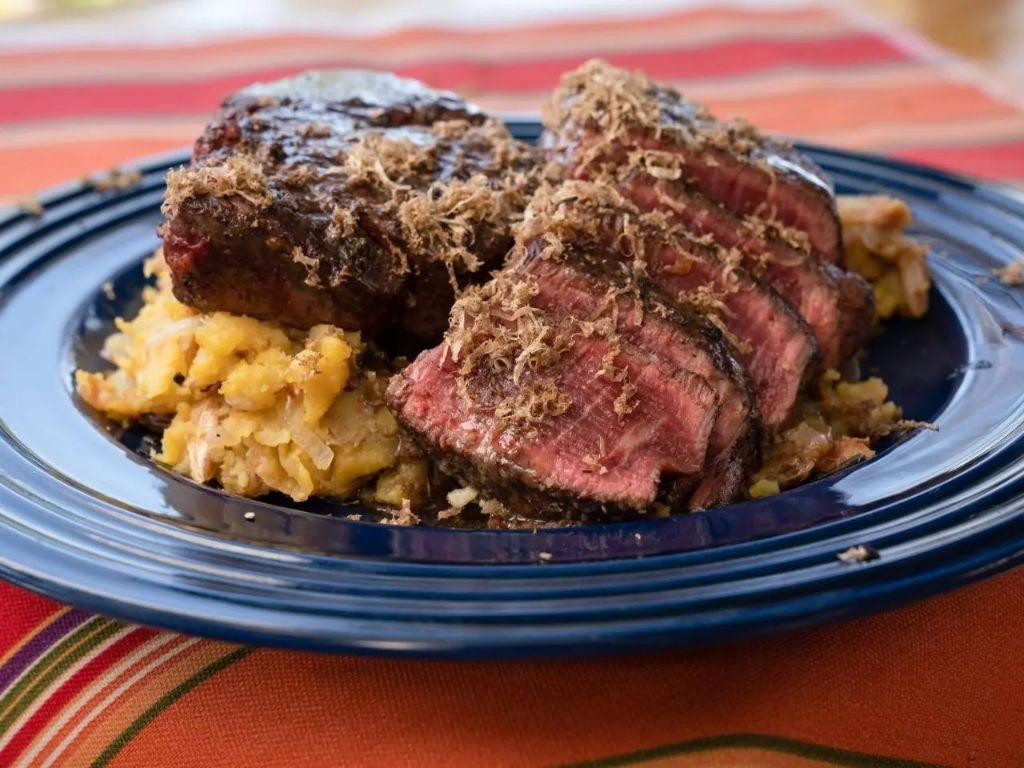
You might think filet mignon is restaurant-only territory, but with this Périgourdine sauce method, you’ll achieve tender, impressive results right at home. Let’s walk through each step together to create this elegant dish that’s surprisingly approachable for any cooking level.
2
servings10
minutes19
minutesIngredients
– 2 (8 oz) filet mignon steaks, about 1.5 inches thick – I always let these come to room temperature for even cooking
– 1 tablespoon unsalted butter – my go-to for rich flavor
– 1 tablespoon olive oil – extra virgin adds nice fruitiness
– 1/4 cup finely chopped shallots – they melt beautifully into the sauce
– 1/2 cup Madeira wine – don’t skip this; it creates the sauce’s complex base
– 1/2 cup beef broth – I prefer low-sodium to control saltiness
– 1/4 cup heavy cream – this creates that luxurious, velvety texture
– 2 tablespoons black truffle paste – the star ingredient that makes it Périgourdine
– 1/4 teaspoon kosher salt – I find this distributes more evenly than table salt
– 1/4 teaspoon freshly ground black pepper – always fresh-ground for maximum aroma
Instructions
1. Pat both filet mignon steaks completely dry with paper towels.
2. Season both sides of each steak evenly with kosher salt and freshly ground black pepper.
3. Heat a heavy skillet over medium-high heat for 2 minutes until hot.
4. Add olive oil to the hot skillet and swirl to coat the surface.
5. Place steaks in the skillet and cook undisturbed for 4 minutes.
6. Flip steaks using tongs and cook for another 4 minutes.
7. Check internal temperature with an instant-read thermometer – aim for 130°F for medium-rare.
8. Transfer steaks to a plate and tent loosely with foil to rest.
9. Reduce skillet heat to medium and add butter to the pan drippings.
10. Add chopped shallots and cook for 2 minutes until translucent.
11. Pour in Madeira wine, scraping up any browned bits from the pan bottom.
12. Simmer the wine mixture for 3 minutes until reduced by half.
13. Add beef broth and continue simmering for 2 minutes.
14. Stir in heavy cream and bring to a gentle bubble.
15. Whisk in black truffle paste until fully incorporated.
16. Simmer the sauce for 2 more minutes until slightly thickened.
17. Remove sauce from heat and adjust consistency if needed.
This preparation yields filet mignon with a beautiful sear outside and butter-soft interior, while the Périgourdine sauce provides earthy, luxurious notes that complement without overwhelming. Try serving over creamy mashed potatoes to catch every drop of that incredible sauce, or alongside roasted asparagus for a complete elegant meal.
Lamb Navarin with Spring Vegetables
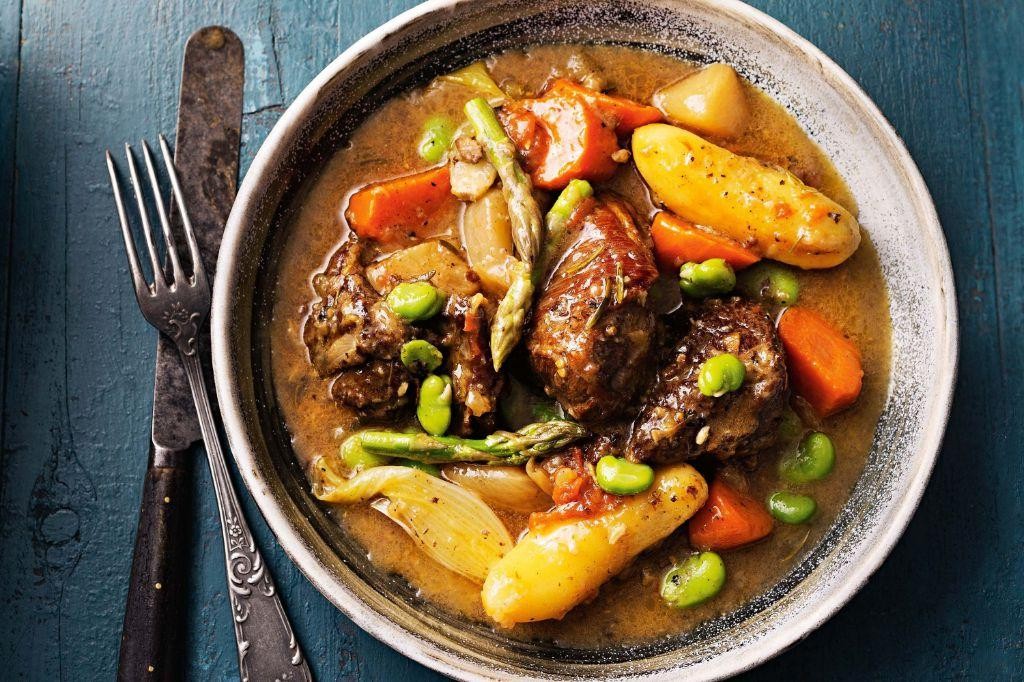
Keeping your kitchen organized while preparing this classic French stew makes the process surprisingly straightforward. Knowing exactly when to add each vegetable ensures they maintain their perfect texture throughout the slow simmering process. Let’s walk through building these layers of flavor methodically.
2
servings25
minutes95
minutesIngredients
- 2 lbs lamb shoulder, cut into 2-inch chunks (I prefer trimming excess fat but leaving some for flavor)
- 2 tbsp extra virgin olive oil (my go-to for both searing and flavor)
- 1 large yellow onion, diced (room temperature onions brown more evenly)
- 2 cloves garlic, minced (freshly minced releases the most aroma)
- 2 tbsp all-purpose flour (this creates the perfect thickening base)
- 4 cups beef broth (homemade if you have it, but good quality store-bought works beautifully)
- 1 tbsp tomato paste (I always keep a tube in the fridge for recipes like this)
- 1 tsp dried thyme (rubbed between your fingers before adding releases more oil)
- 2 medium carrots, cut into 1-inch pieces (peeled and trimmed for sweetest flavor)
- 8 oz baby potatoes, halved (I love the creamy texture these small potatoes provide)
- 1 cup frozen peas (straight from the freezer preserves their bright green color)
- 2 tbsp chopped fresh parsley (added at the end for maximum freshness)
- Salt and black pepper (I use about 1 tsp salt and ½ tsp pepper total throughout cooking)
Instructions
- Pat the lamb chunks completely dry with paper towels to ensure proper browning.
- Season all sides of the lamb generously with ½ teaspoon salt and ¼ teaspoon black pepper.
- Heat 1 tablespoon olive oil in a large Dutch oven over medium-high heat until shimmering.
- Working in batches, sear the lamb chunks until deeply browned on all sides, about 3-4 minutes per side.
- Transfer the browned lamb to a clean plate, leaving any rendered fat in the pot.
- Add the remaining 1 tablespoon olive oil to the same pot over medium heat.
- Sauté the diced onion until translucent and lightly golden, about 5 minutes.
- Add the minced garlic and cook until fragrant, exactly 1 minute to prevent burning.
- Sprinkle the flour over the onion mixture and cook, stirring constantly, for 2 minutes to form a roux.
- Whisk in the beef broth gradually until the mixture is smooth and begins to thicken.
- Stir in the tomato paste and dried thyme until fully incorporated.
- Return the seared lamb and any accumulated juices back to the pot.
- Bring the mixture to a gentle simmer, then reduce heat to low, cover, and cook for 45 minutes.
- Add the carrot pieces and halved potatoes to the pot, stirring to combine.
- Cover and continue simmering for another 30 minutes until vegetables are fork-tender.
- Stir in the frozen peas and cook uncovered for 5 minutes to heat through.
- Remove from heat and stir in the chopped fresh parsley.
- Season with remaining ½ teaspoon salt and ¼ teaspoon black pepper, tasting and adjusting as needed.
Buttery soft lamb practically falls apart at the touch of your fork, while the vegetables maintain just enough structure to provide satisfying texture contrasts. The rich broth clings beautifully to each component, making every spoonful a perfect balance of savory depth and spring freshness. Consider serving this in shallow bowls with crusty bread for dipping, or over creamy polenta to soak up every last drop of the flavorful sauce.
Veal Blanquette in Creamy White Sauce

Zesty yet comforting, this veal blanquette brings elegant French cooking right to your weeknight table. Gently simmered in a creamy white sauce, the tender veal melts in your mouth while the aromatic vegetables create a harmonious base. Let’s walk through each step together to create this restaurant-quality dish in your own kitchen.
4
servings20
minutes105
minutesIngredients
- 2 lbs veal shoulder, cut into 2-inch cubes (I prefer grass-fed for better flavor)
- 3 tbsp unsalted butter (European-style butter makes the sauce extra rich)
- 1 large yellow onion, finely diced (the sweet variety works beautifully here)
- 2 medium carrots, peeled and sliced into 1/4-inch rounds
- 3 cloves garlic, minced (freshly minced releases the most aroma)
- 1/2 cup dry white wine (I always use Sauvignon Blanc for its crisp acidity)
- 4 cups chicken broth (homemade if you have it, but good quality store-bought works fine)
- 1 cup heavy cream (bring it to room temperature for smoother incorporation)
- 2 tbsp all-purpose flour (I spoon and level for accurate measurement)
- 1 bay leaf (fresh if available, otherwise dried works perfectly)
- 1/2 tsp freshly grated nutmeg (freshly grated makes all the difference)
- 2 tbsp fresh parsley, chopped (flat-leaf parsley has the best flavor)
- 1 tsp lemon juice (freshly squeezed brightens the entire dish)
Instructions
- Pat the veal cubes completely dry with paper towels—this ensures proper browning.
- Melt 2 tablespoons of butter in a large Dutch oven over medium-high heat until foaming subsides, about 2 minutes.
- Working in two batches, brown the veal cubes for 3-4 minutes per side until golden brown, transferring to a plate when done.
- Reduce heat to medium and add the remaining 1 tablespoon of butter to the same pot.
- Add the diced onion and cook for 5 minutes until translucent, stirring frequently.
- Stir in the carrot rounds and cook for another 3 minutes until slightly softened.
- Add the minced garlic and cook for 1 minute until fragrant—be careful not to burn it.
- Pour in the white wine, scraping up any browned bits from the bottom of the pot.
- Simmer the wine for 2 minutes until reduced by half, allowing the alcohol to cook off.
- Sprinkle the flour over the vegetables and cook for 1 minute while stirring constantly.
- Gradually whisk in the chicken broth until the mixture is smooth and lump-free.
- Return the browned veal and any accumulated juices to the pot.
- Add the bay leaf and bring the mixture to a gentle simmer.
- Reduce heat to low, cover, and simmer for 1 hour and 15 minutes until the veal is fork-tender.
- Remove the bay leaf and stir in the heavy cream and grated nutmeg.
- Simmer uncovered for 10 minutes until the sauce thickens slightly—don’t let it boil.
- Stir in the chopped parsley and fresh lemon juice just before serving.
Gloriously creamy with tender veal that falls apart at the slightest pressure, this blanquette delivers comfort in every spoonful. The subtle nutmeg and bright lemon create layers of flavor that make this feel both rustic and refined. Serve it over buttered egg noodles or creamy mashed potatoes to soak up every drop of that luxurious sauce.
Steak au Poivre with Brandy Cream
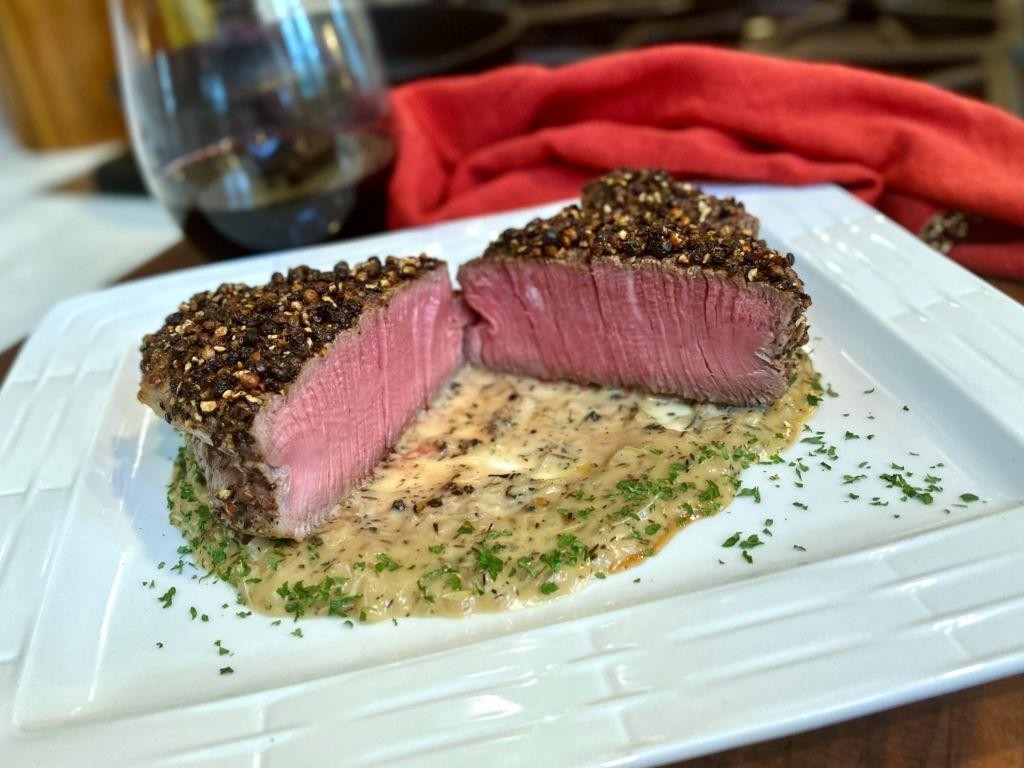
Remember that classic French bistro dish that always feels intimidating? Steak au Poivre with Brandy Cream is actually quite approachable when broken down step by step. Let me guide you through creating this elegant, restaurant-worthy meal in your own kitchen.
2
servings10
minutes22
minutesIngredients
– 2 (8-ounce) beef tenderloin steaks, about 1½ inches thick—I find this thickness gives you the perfect sear-to-pink interior ratio
– 2 tablespoons whole black peppercorns, freshly cracked for maximum aroma
– 1 teaspoon kosher salt, my preferred choice for even seasoning
– 1 tablespoon vegetable oil, which has a higher smoke point than olive oil for better searing
– 2 tablespoons unsalted butter, divided—I always keep half chilled for finishing the sauce
– ¼ cup finely chopped shallot, about 1 medium shallot
– ¼ cup brandy, use one you’d actually drink for best flavor
– ½ cup heavy cream, the rich base for our luxurious sauce
– 2 tablespoons fresh parsley, chopped right before using for brightest color
Instructions
1. Pat both steaks completely dry with paper towels to ensure proper searing.
2. Crack peppercorns using a spice grinder or mortar and pestle until coarsely ground.
3. Press cracked pepper firmly onto both sides of each steak, covering the entire surface.
4. Season both sides of steaks evenly with kosher salt.
5. Heat a large skillet over medium-high heat for 2 minutes until hot.
6. Add vegetable oil to the hot skillet and swirl to coat the bottom.
7. Place steaks in the skillet and cook undisturbed for 4 minutes to develop a crust.
8. Flip steaks using tongs and cook for another 4 minutes for medium-rare.
9. Transfer steaks to a plate and let rest for 8 minutes—this keeps them juicy.
10. Reduce skillet heat to medium and add 1 tablespoon butter.
11. Add chopped shallot and cook for 2 minutes until softened and fragrant.
12. Carefully pour brandy into the skillet, standing back as it may flame up.
13. Cook brandy for 1 minute, scraping up all the browned bits from the pan bottom.
14. Pour in heavy cream and bring to a gentle simmer.
15. Cook sauce for 3 minutes, stirring constantly until slightly thickened.
16. Remove skillet from heat and stir in remaining 1 tablespoon cold butter.
17. Stir in chopped parsley until evenly distributed throughout the sauce.
18. Spoon brandy cream sauce over the rested steaks and serve immediately.
That creamy, peppery crust gives way to tender beef that melts in your mouth. The brandy cream sauce clings beautifully to each slice, creating a luxurious coating that’s neither too thick nor too thin. Try serving this over crispy roasted potatoes to soak up every last drop of that incredible sauce.
Pork Rillettes with Aromatic Spices

Let’s explore the comforting world of pork rillettes, where slow-cooked pork transforms into a luxurious spread that’s perfect for entertaining or simple snacking. This methodical approach will guide you through creating tender, aromatic pork rillettes that melt in your mouth, using spices that fill your kitchen with the most wonderful fragrance as they cook.
8
servings15
minutes210
minutesIngredients
– 2 pounds pork shoulder, cut into 2-inch cubes (I find this cut provides the perfect balance of fat and meat)
– 1/2 cup dry white wine (a crisp Sauvignon Blanc works beautifully here)
– 4 garlic cloves, smashed (fresh garlic makes all the difference in flavor)
– 1 tablespoon black peppercorns (I prefer whole peppercorns for better aroma control)
– 2 teaspoons kosher salt (this coarse salt distributes more evenly than table salt)
– 1 teaspoon coriander seeds (toasting these first really wakes up their citrusy notes)
– 1/2 teaspoon fennel seeds (my secret weapon for adding subtle licorice warmth)
– 2 bay leaves (I always keep quality bay leaves in my pantry for dishes like this)
– 1/4 cup duck fat or lard (duck fat adds incredible richness, but lard works wonderfully too)
Instructions
1. Preheat your oven to 300°F to ensure even, gentle cooking throughout the process.
2. Combine pork shoulder, white wine, garlic cloves, black peppercorns, kosher salt, coriander seeds, fennel seeds, and bay leaves in a Dutch oven or heavy oven-safe pot.
3. Cover the pot tightly with its lid to trap all the moisture and flavors during the long cooking time.
4. Place the covered pot in the preheated oven and cook for exactly 3 hours and 30 minutes until the pork shreds easily with a fork.
5. Remove the pot from the oven using oven mitts and let it cool for 20 minutes until safe to handle.
6. Strain the cooking liquid through a fine-mesh sieve into a bowl, pressing on the solids to extract all the flavorful juices.
7. Transfer the cooked pork and spices to a large mixing bowl, discarding the bay leaves but keeping the other spices for texture.
8. Use two forks to shred the pork completely, incorporating the softened spices throughout the meat.
9. Mix in the duck fat and 1/4 cup of the reserved cooking liquid until the mixture becomes spreadable but still maintains some texture.
10. Pack the rillettes mixture firmly into clean jars or ramekins, pressing down to eliminate any air pockets.
11. Pour a thin layer of the remaining cooking liquid over the top of each jar to seal and preserve the rillettes.
12. Refrigerate the jars for at least 6 hours, or preferably overnight, to allow the flavors to meld and the texture to firm up.
The finished rillettes should have a coarse, spreadable texture with visible shreds of pork and specks of aromatic spices throughout. When properly chilled, they develop a rich, complex flavor where the subtle licorice notes from fennel complement the pork’s natural sweetness beautifully. Serve them spread thickly on crusty baguette slices with cornichons, or try them as an unexpected filling for breakfast sandwiches with a fried egg.
Provençal Daube with Caramelized Onions
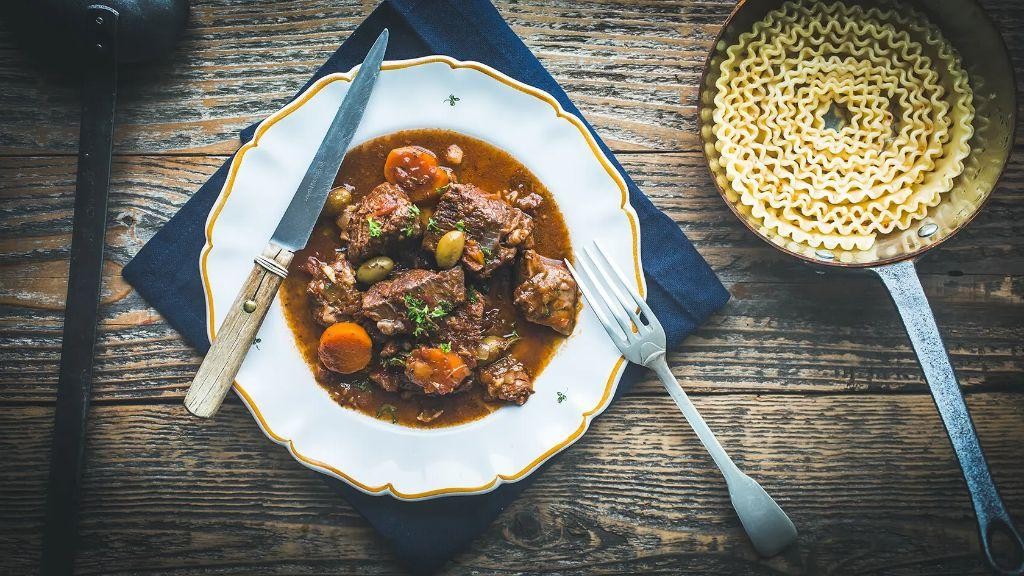
Slow-cooked comfort food doesn’t get much better than this Provençal daube, which transforms humble beef into a meltingly tender masterpiece with minimal hands-on effort. Simmering the beef low and slow in red wine with aromatic herbs creates a rich, complex sauce that’s perfect for chilly evenings. This methodical approach ensures even beginners can achieve restaurant-quality results right at home.
4
servings25
minutes210
minutesIngredients
– 2 pounds beef chuck roast, cut into 2-inch cubes (I prefer grass-fed for deeper flavor)
– 2 large yellow onions, thinly sliced (sweet varieties work beautifully here)
– 3 tablespoons extra virgin olive oil (my go-to for its fruity notes)
– 1 cup dry red wine (a robust Cabernet Sauvignon is ideal)
– 2 cups beef broth (homemade if you have it, but good quality store-bought works)
– 4 garlic cloves, minced (freshly minced releases the most aroma)
– 2 tablespoons tomato paste (I always keep a tube in the fridge for convenience)
– 1 bay leaf (dried works perfectly for long cooking)
– 1 teaspoon dried thyme (rubbed between your fingers before adding)
– 1 teaspoon salt (fine sea salt distributes evenly)
– ½ teaspoon black pepper (freshly cracked for best flavor)
Instructions
1. Pat the beef cubes completely dry with paper towels—this ensures proper browning.
2. Heat 2 tablespoons olive oil in a large Dutch oven over medium-high heat until shimmering.
3. Working in batches, brown the beef cubes for 3-4 minutes per side until deeply caramelized.
4. Transfer all browned beef to a plate, leaving any rendered fat in the pot.
5. Add the remaining 1 tablespoon olive oil to the same pot over medium heat.
6. Cook the sliced onions for 15-18 minutes, stirring occasionally, until golden brown and softened.
7. Add the minced garlic and cook for 1 minute until fragrant but not browned.
8. Stir in the tomato paste and cook for 2 minutes until it darkens slightly in color.
9. Pour in the red wine, scraping up all the browned bits from the bottom of the pot.
10. Simmer the wine for 4-5 minutes until reduced by about half.
11. Return the browned beef and any accumulated juices to the pot.
12. Add the beef broth, bay leaf, thyme, salt, and pepper.
13. Bring the mixture to a gentle simmer, then reduce heat to low.
14. Cover the pot and simmer for 2.5-3 hours until the beef is fork-tender.
15. Remove the bay leaf before serving.
This daube develops an incredible silky texture where the beef practically dissolves on your tongue. The caramelized onions melt into the sauce, creating a sweet-savory balance that pairs wonderfully with creamy polenta or crusty bread for soaking up every last drop.
Roast Chicken Provençale with Herbes de Provence
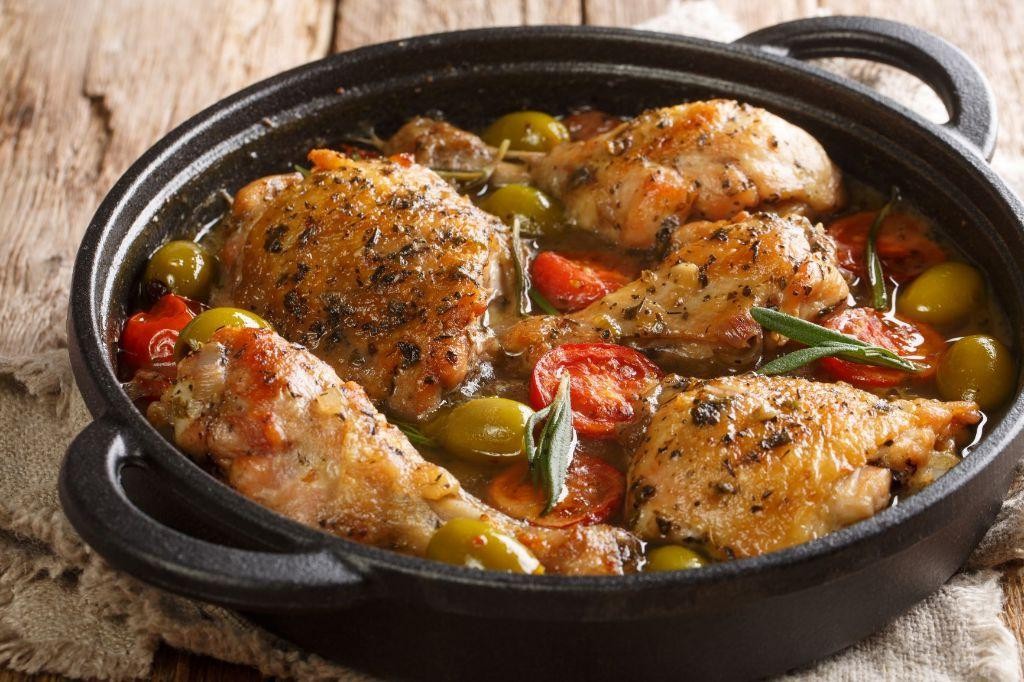
Creating a perfect roast chicken doesn’t require fancy techniques—just good ingredients and proper timing. This Provençale version fills your kitchen with the most incredible aromas of garlic and herbs while keeping the meat incredibly juicy. Follow these steps carefully for a restaurant-quality result you’ll make again and again.
4
servings15
minutes60
minutesIngredients
– 1 whole chicken (3-4 pounds) – I always pat mine completely dry for maximum crispiness
– 3 tablespoons extra virgin olive oil – my go-to for its fruity flavor
– 2 tablespoons Herbes de Provence – crush between your palms to release the oils
– 4 garlic cloves – smashed lightly to peel easily
– 1 lemon – room temperature rolls better for maximum juice
– 1 teaspoon kosher salt – I prefer the larger crystals for better seasoning control
– ½ teaspoon black pepper – freshly ground makes all the difference
Instructions
1. Preheat your oven to 425°F and position the rack in the middle.
2. Pat the chicken completely dry inside and out with paper towels.
3. Rub the entire chicken with olive oil, making sure to coat every surface.
4. Sprinkle salt and pepper evenly over the skin and inside the cavity.
5. Rub the Herbes de Provence all over the exterior, pressing gently to adhere.
6. Place the smashed garlic cloves inside the chicken cavity.
7. Cut the lemon in half and squeeze the juice over the chicken.
8. Place both lemon halves inside the cavity with the garlic.
9. Truss the chicken legs together with kitchen twine.
10. Place the chicken breast-side up in a roasting pan.
11. Roast for 50-60 minutes until the skin is golden brown and crispy.
12. Check for doneness – the internal temperature should read 165°F in the thickest part of the thigh.
13. Remove from oven and let rest for 15 minutes before carving.
14. Carve the chicken and serve immediately.
Juicy, tender meat falls right off the bone with crispy, herb-infused skin that crackles with each bite. The garlic and lemon steam from inside creates the most incredible aromatic sauce that soaks into every morsel. Try serving it over crusty bread to catch all those delicious pan juices, or pair with roasted vegetables for a complete meal that tastes like you’re dining in the French countryside.
Rabbit a la Moutarde with Dijon Mustard

Now, let’s tackle this classic French dish that transforms simple rabbit into something truly special with the tangy punch of Dijon mustard. Nothing beats the comforting aroma that fills your kitchen as this simmers away, making it perfect for a cozy dinner that feels both rustic and refined.
5
portions15
minutes68
minutesIngredients
– 1 whole rabbit (about 3 lbs), cut into 8 pieces—I find asking your butcher to do this saves time and ensures even cooking
– 2 tbsp extra virgin olive oil, my go-to for its fruity notes that complement the mustard
– 1 large yellow onion, thinly sliced—sweet varieties like Vidalia work beautifully here
– 3 cloves garlic, minced finely for even distribution
– 1 cup dry white wine, such as Sauvignon Blanc, which adds brightness without overpowering
– 1/2 cup chicken broth, preferably low-sodium to control salt levels
– 1/4 cup Dijon mustard, the star ingredient that gives this dish its name and zing
– 1/2 cup heavy cream, bringing a luxurious richness to the sauce
– 1 tsp fresh thyme leaves, stripped from stems for their earthy fragrance
– Salt and freshly ground black pepper, to season layers as you go
Instructions
1. Pat the rabbit pieces completely dry with paper towels to ensure a golden sear.
2. Season all sides of the rabbit generously with salt and pepper.
3. Heat the olive oil in a large, heavy-bottomed Dutch oven over medium-high heat until it shimmers.
4. Sear the rabbit pieces in batches, about 4 minutes per side, until deeply browned—avoid crowding the pan for proper caramelization.
5. Transfer the seared rabbit to a plate, reserving any drippings in the pot.
6. Add the sliced onion to the pot and sauté for 5 minutes, stirring occasionally, until softened and translucent.
7. Stir in the minced garlic and cook for 1 minute until fragrant but not browned.
8. Pour in the white wine, scraping up any browned bits from the bottom with a wooden spoon—this deglazing step builds foundational flavor.
9. Simmer the wine for 3 minutes until reduced by half, concentrating its acidity.
10. Whisk in the Dijon mustard until fully incorporated with the wine and onions.
11. Pour in the chicken broth and add the fresh thyme leaves, stirring to combine.
12. Return the rabbit pieces to the pot, nestling them into the sauce in a single layer.
13. Bring the liquid to a gentle boil, then immediately reduce heat to low.
14. Cover the pot and simmer for 45 minutes, until the rabbit is fork-tender and easily pulls away from the bone.
15. Transfer the cooked rabbit to a serving platter, tenting loosely with foil to keep warm.
16. Stir the heavy cream into the remaining sauce in the pot.
17. Increase heat to medium and simmer the sauce uncovered for 5 minutes, until slightly thickened—it should coat the back of a spoon.
18. Taste the sauce and adjust seasoning with additional salt or pepper if needed.
19. Pour the finished mustard sauce over the plated rabbit pieces.
Keep in mind that the rabbit should be fall-off-the-bone tender, with the creamy mustard sauce clinging to each piece. Its tangy richness pairs wonderfully with buttery mashed potatoes or crusty bread to soak up every last drop, making for a meal that feels both elegant and utterly comforting.
Charcuterie Terrine with Pistachios and Cognac

This elegant charcuterie terrine might look complex, but breaking it down into simple steps makes it surprisingly approachable for home cooks. Think of it as building delicious layers of flavor that come together beautifully when sliced. Today we’ll create a stunning centerpiece that’s perfect for entertaining or special occasions.
8
servings25
minutes90
minutesIngredients
– 1 pound ground pork shoulder (I find the higher fat content creates the best texture)
– 8 ounces chicken livers, cleaned and trimmed (fresh livers make all the difference)
– 1/2 cup shelled pistachios (I prefer raw for better color retention)
– 1/4 cup cognac (a good quality brandy really elevates the flavor)
– 2 teaspoons kosher salt (I always use Diamond Crystal for more consistent results)
– 1 teaspoon black pepper, freshly ground
– 1/2 teaspoon pink curing salt (this ensures food safety and gives that classic charcuterie color)
– 1/4 teaspoon ground allspice
– 2 tablespoons ice water (cold liquid helps keep the fat from melting)
Instructions
1. Place the ground pork shoulder and chicken livers in a large mixing bowl.
2. Add the kosher salt, black pepper, pink curing salt, and ground allspice to the meat mixture.
3. Pour the cognac over the ingredients and mix thoroughly with your hands for exactly 2 minutes until well combined.
4. Fold in the shelled pistachios gently to distribute them evenly without crushing.
5. Add the ice water and mix for another 30 seconds until the mixture becomes slightly sticky.
6. Line a 9×5 inch loaf pan with plastic wrap, leaving several inches of overhang on all sides.
7. Press the meat mixture firmly into the prepared pan, eliminating any air pockets.
8. Fold the plastic wrap overhang over the top to completely seal the terrine.
9. Place the loaf pan in a larger baking dish and fill the larger dish with hot water until it reaches halfway up the sides of the loaf pan.
10. Bake in a preheated 300°F oven for 90 minutes until the internal temperature reaches 150°F on an instant-read thermometer.
11. Remove the terrine from the water bath and let it cool at room temperature for 1 hour.
12. Place weights (I use canned goods) on top of the terrine and refrigerate for at least 24 hours before serving.
Gorgeous when sliced, this terrine reveals beautiful marbled layers with vibrant green pistachio accents. The cognac adds subtle warmth while the chicken livers provide that classic pâté-like richness. Serve thin slices on crusty baguette with cornichons and grainy mustard for the perfect charcuterie board addition.
Conclusion
Your culinary journey through France awaits with these 22 exquisite meat recipes. From rustic stews to elegant roasts, each dish brings authentic French flavor to your kitchen. We hope you’ll try these recipes, leave a comment sharing your favorites, and pin this article on Pinterest to inspire fellow food lovers. Bon appétit!
